SSZTBG9 March 2016 FDC2214 , MSP430F5132 , TMS320F28020 , TPS92513 , UCC27714 , UCC28911
Seetharaman Devendran
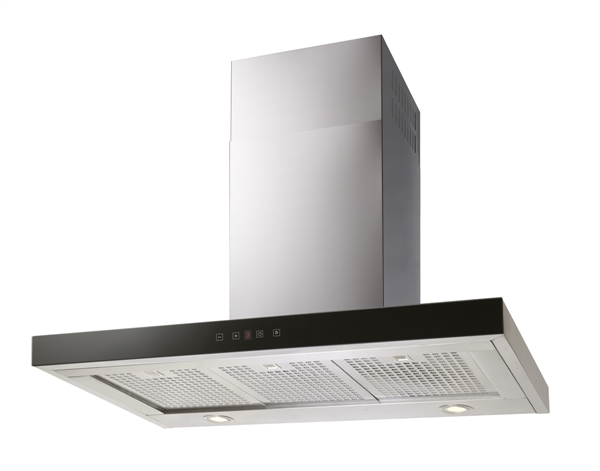
Cooker hoods extract steam, fumes and cooking odors from kitchens. Depending on the country, cooker hoods are also called kitchen hoods, fumes extractors and kitchen extractor fans. Next-generation cooker hoods include sensing, motor control, bias power supply, lighting and a user interface, besides the overall mechanical design and aesthetics. Figure 1 shows the sub systems of a new generation cooker hood. Major design aspects of cooker hood are a) lower acoustics, b) energy efficiency, c) elegant user interface and d) sensors for advanced control. In this post, I’ll discuss how semiconductor components add value to create a differentiated cooker hood.
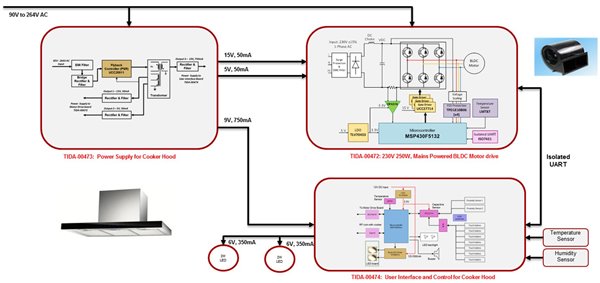 Figure 1 Cooker Hood System Block
Diagram
Figure 1 Cooker Hood System Block
DiagramLower Acoustics
Because a motor drive is needed to turn the cooker hood’s suction fan, the choice of motor and its control design are key to achieving lower acoustic noise. With a low-cost single-phase split-capacitor AC induction motor, the speed variation of the motor powering the suction fan is achieved through the tapped winding. Only step changes in speed are possible based on the number of taps in the winding. Although this is a simple and low-cost solution, the motor produces higher torque ripple, which leads to higher vibration levels and higher acoustic noise.
A three-phase brushless DC (BLDC) motor is better in terms of torque ripple. A permanent magnet alternating current (PMAC) motor/permanent magnet synchronous motor (PMSM) provides the lowest acoustic performance, because of low torque ripple. Using BLDC or PMSM motors enable smooth speed variations, unlike the step-speed change in a single-phase AC motor with tapped winding.
The introduction of BLDC motors or PMSMs necessitates an efficient inverter stage and effective control algorithms. Texas Instruments offers microcontrollers (MCUs) with the necessary peripherals and features for efficient motor control, along with high-voltage gate drivers for low switching losses and current-sensing amplifiers for sensorless operation and protection. Along with the semiconductor components, customizable motor control algorithms such as InstaSPIN™ BLDC and InstaSPIN-FOC™ field-oriented control (FOC) enable manufacturers to develop a new generation of cooker hoods.
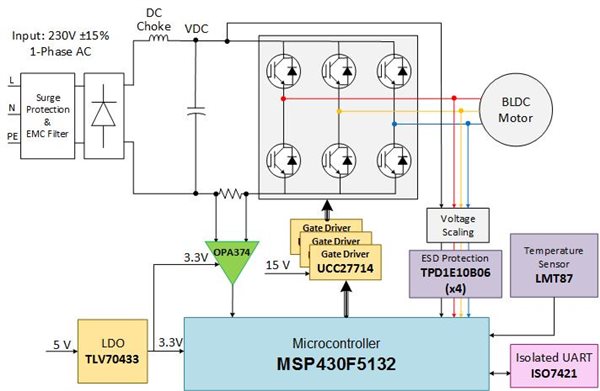 Figure 2 Block Diagram of a Simple 250W BLDC Three-phase Inverter Drive Stage for a 300V BLDC Motor
Figure 2 Block Diagram of a Simple 250W BLDC Three-phase Inverter Drive Stage for a 300V BLDC MotorCombined with the potential for automatic speed control of the motor based on conditions under the hood such as temperature and fumes, the smooth variable speed further lowers overall acoustic noise level.
Energy Efficiency
Single-phase AC motors have lower efficiency at rated speeds compared to BLDC motors or PMSMs; an AC motor’s efficiency drops drastically at reduced speeds. A BLDC motor or PMSM offers higher efficiency over the entire speed range. Another factor contributing to overall system efficiency is the efficiency of the inverter stage, determined by the selection of insulated-gate bipolar transistors (IGBTs), MOSFETs and gate drivers. Gate drivers like TI’s UCC27714 offer 4A sink/4A source capacity to keep switching losses to a minimum for inverters of varying power levels, from a few hundred watts to few kilowatts.
The UCC27714 driver also features a unique architecture on the pull-up structure that delivers the highest peak-source current when it is most needed during the Miller plateau region of the power-switch turn-on transition (when the power-switch drain or collector voltage experiences dV/dt). A high-efficiency power stage helps reduce the generation of heat from the power stage and thus enables the use of a smaller-sized heat sink, or even the elimination of the heat sink.
The InstaSPIN-BLDC software algorithm implemented in the TI MSP430F5132 MCU makes BLDC motor control simpler, easier and robust compared to a back-electromotive force (EMF) zero-crossing detection method. The ultra-low power MSP430™ MCU’s built-in analog-to-digital converter (ADC), pulse-width modulator (PWM), comparator and hardware multiplier offers high performance with low power consumption. The internal comparator with output glitch filter, along with a timer-event control module, directly interface with the timer to truncate the PWM cycle by cycle in the event of overcurrent, enabling torque control and overcurrent protection without software intervention.
In the cooker-hood lamp, two halogen or tungsten lamps consume power in the range of 25W to 50W. High-power light-emitting diodes (LEDs) combined with efficient LED drivers such as TI’s TPS92513 not only help reduce the power consumption of the lamps significantly, they also enable easy lossless dimming.
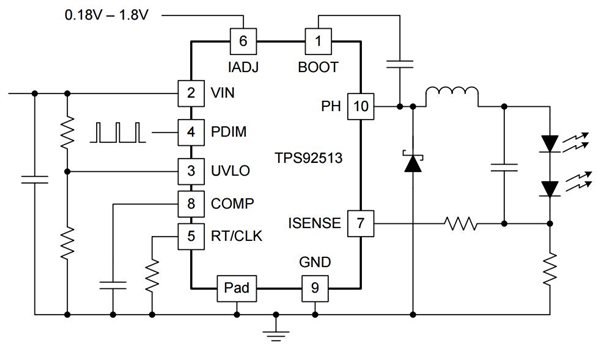 Figure 3 1.5A Buck LED Driver with Integrated Analog Current Adjust
Figure 3 1.5A Buck LED Driver with Integrated Analog Current Adjust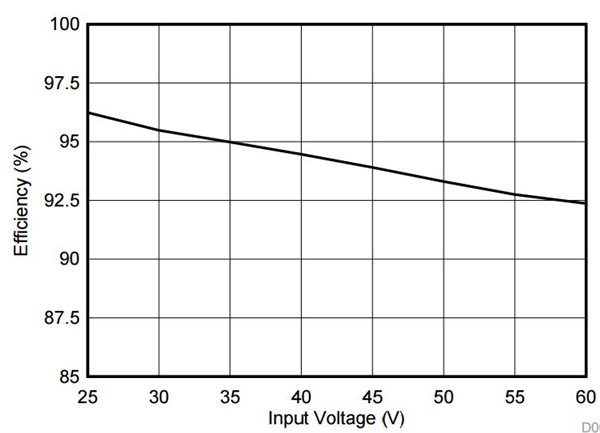 Figure 4 Efficiency vs. Input Voltage of Seven White LEDs at 1.5A (VOUT = 23V)
Figure 4 Efficiency vs. Input Voltage of Seven White LEDs at 1.5A (VOUT = 23V)The standby power consumption of the bias power supply is also an important criteria for Energy Star ratings. TI’s UCC28911 flyback converter helps achieve very low standby power consumption while providing higher efficiency. This device has an integrated 700V switch, primary-side regulation, an integrated high-voltage current source for startup that switches off during device operation and dynamic adjustment of controller current consumption with load.
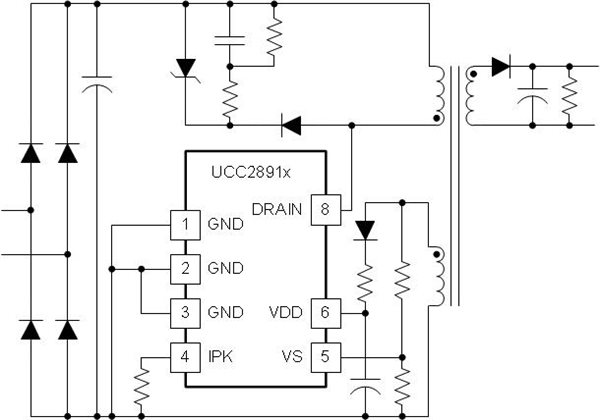 Figure 5 Flyback Switcher with Integrated 700V Switch and Low Standby Power Consumption
Figure 5 Flyback Switcher with Integrated 700V Switch and Low Standby Power ConsumptionElegant User Interface
Capacitive touch buttons and sliders play an important role in a cooker hood’s aesthetics and its user experience. The environment makes fast and error-free responses challenging, given likely conditions such as steam, oily coatings and users with wet hands. The main challenge limiting sensitivity in capacitive-sensing applications is the sensor’s noise susceptibility. With TI’s FDC2x1x’s electromagnetic interference (EMI)-resistant architecture, performance remains unaffected even in high-noise environments. The FDC2x1x is a multichannel family of noise- and EMI-resistant, high-resolution, high-speed capacitance-to-digital converters for capacitive-sensing solutions. The devices employ a narrowband-based architecture to offer high rejection of noise and interference while providing high resolution at high speed. The devices support a wide excitation-frequency range, offering flexibility in system design.
The FDC221x is optimized for high resolution (up to 28 bits), while the FDC211x offers a 13.3KSPS sample rate for implementation of applications that use fast-moving targets. The 250nF maximum input capacitance enables the use of remote sensors and the capability to track environmental changes over time, temperature and humidity. Devices like the FDC2214 enable the implementation of touch buttons and proximity sensing as well. With the proximity-sensing feature, you can also implement gesture sensing in the software.
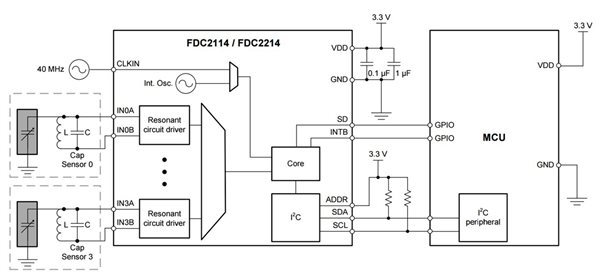 Figure 6 Application Schematic of FDC2214 Capacitance to Digital Converter
Figure 6 Application Schematic of FDC2214 Capacitance to Digital ConverterSensors
Temperature, humidity and gas sensors provide information about the conditions under the hood, which can then trigger automatic adjustment of the fan speed, providing lower acoustic noise and low-power operation. Semiconductor devices that recognize specific voice commands can add a voice-command feature easily to the end product without coding for signal processing. High-resolution proximity sensing can help implement simple gesture control.
The differentiated features of the semiconductor components such as capacitive sensors, flyback switcher, LED driver, MOSFET/IGBT gate driver and microcontroller along with ready motor control software enable the next generation high performance, energy efficient cooker hood.
Additional Resources
- Check out these related TI Designs reference designs:
- 230V, 250W, High-Efficiency BLDC Motor Drive with DC Bus Voltage Ripple Compensation Reference Design.
- The Universal Input, 10W, High-Efficiency Low-Cost Power Supply with Isolated Multiple Inputs reference design is suitable for applications like cooker hoods and other appliances involving a motor driver and user interface.
- The Robust, High Res Capacitive Touch and Proximity Sensing User Interface (UI) with LED Lighting Reference Design was designed and tested in a cooker-hood environment.
- Learn more about these related products: